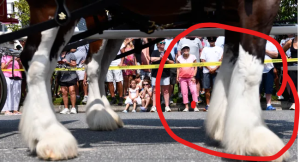The Budweiser Clydesdales marched (trotted?) down the streets of Margate on Aug. 15, but do you know why they’re so famous?
Well, the story dates back to 1933, according to the Anheuser-Busch website.
How did the Budweiser Clydesdales originate?
To commemorate the end of the Prohibition era, when alcohol had been made illegal, August A. Busch Jr. and Adolphus Busch III surprised their father, August A. Busch Sr., with a six-horse Clydesdale hitch.
Thus began the beginning of a horse-drawn beer wagon as well as the order for a second six-horse hitch to be sent to New York to mark Prohibition’s end. The spectacle drew crowds of thousands, the brand says, as people gathered to watch the horses make their way to the Empire State Building, where New York Gov. Alfred E. Smith received a case of Budweiser for his role in fighting Prohibition.
Next, the hitch would tour New England and the Mid-Atlantic states, drawing crowds to see the horse-drawn beer wagon and a now-important symbolism of the reborn beer industry and the end of Prohibition.
Soon, the group of six became eight, and in 1950 a Dalmatian was introduced as the Clydesdales’ mascot to commemorate the Anheuser-Busch Newark Brewery.
More:Roy Gillian, founder of Ocean City Wonderland Pier, has died. What he meant to Jersey shore
What was Prohibition?
The Prohibition era took place in the United States from 1919 to 1933, after the ratification of the 18th Amendment to the Constitution banned the manufacture, transportation and sale of intoxicating liquors.
This era brought life to terms like “bootlegging” and “speakeasies,” which reference the illegal transportation of liquors and undercover or secret places to engage in drinking.
The amendment itself was a result of the country’s temperance movement and Anti-Saloon League, which blamed alcohol as a cause of social distresses such as domestic violence and poverty, and campaigned for its outlaw at local, state and federal levels, as noted in the Encyclopedia Britannica. But many would flout the law, and Prohibition itself was blamed for the rise in organized crime seeking to meet the demand for illegal alcohol. It was repealed by the 21st Amendment in 1933.

More:Vineland marijuana facility growing as demand soars in New Jersey
How are the Budweiser Clydesdales cared for?
According to Anheuser-Busch, the Clydesdales, now a group of ten, make hundreds of appearances each year, and a lot goes into maintaining their iconic look.
Expert groomers travel with the hitch for 10 months a year, making sure they look their best. Other handlers take care of the team’s diets. Each horse consumes up to 25 quarts of whole grains, minerals and vitamins, 60 pounds of hay and 30 gallons of water on a warm day.
During travel, drivers keep an eye on the horses with special cameras connected to their trailers, which are equipped with air-cushioned suspension and thick rubber flooring. Each night the horses rest in local stables.

Where to see the Budweiser Clydesdales
Aside from event visitations, the Clydesdales can be seen seasonally at the Anheuser-Busch Breweries in St. Louis, Missouri, where they reside, or at Warm Springs Ranch, the breeding establishment in Boonville, Missouri.
You may also recognize the hitch from Super Bowl commercials going as far back as 1975.

